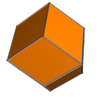Zonotope
A zonotope is a convex polytope that is the Minkowski sum of a set of closed line segments, called its generators.
A zonotope can also be defined as a convex polytope whose facets are all zonotopes and which has central inversion symmetry.
Properties[edit | edit source]
The faces of a zonotope always have an even number of edges, and the facets of a zonotope are themselves zonotopes.
An n-dimensional zonotope can always be dissected into "primitive" zonotopes (which are n-parallelotopes, or the generalization of parallelograms and parallelepipeds to n dimensions).
Examples[edit | edit source]
2D (zonogons)[edit | edit source]
All polygons with point symmetry (that is, they have a symmetry that rotates them 180° about the center) are zonotopes, and all convex regular 2n-gons are zonotopes. These are usually found as the faces of higher-dimensional zonotopes.
3D (zonohedra)[edit | edit source]
Of the convex uniform polyhedra, the omnitruncates (the truncated octahedron, truncated cuboctahedron, truncated icosidodecahedron and the even-gonal prisms, esp. the cube) are zonotopes.
Two of the uniform dual polyhedra - the rhombic dodecahedron and rhombic triacontahedron - are also zonotopes.
Removing one or two generators from the rhombic triacontahedron results in the rhombic icosahedron and Bilinski dodecahedron, respectively. Both are also zonotopes.
The prism of any 2D zonotope is a 3D zonotope as well.
4D (zonochora)[edit | edit source]
Of the uniform polychora, the tesseract, great prismatodecachoron, great disprismatotesseractihexadecachoron, truncated icositetrachoron, great prismatotetracontoctachoron, and great disprismatohexacosihecatonicosachoron are zonotopes.
Duoprisms of two 2n-gons are also zonotopes, as are the prisms of 3D zonotopes.
Zonohedrification[edit | edit source]

Take any convex polytope P with a well-defined center, and connect every vertex to the center using line segments. The Minkowski sum of these line segments is the zonohedrification of P, a term coined by George Hart.[1][2] Several zonohedrifications are pictured below.
| Input polyhedron | Generators made | Output polyhedron | ||
|---|---|---|---|---|

|
tetrahedron | 4 | 
|
rhombic dodecahedron |
| cube | 4 | 
|
rhombic dodecahedron | |
| octahedron | 3 | cube | ||

|
dodecahedron | 10 | 
|
rhombic enneacontahedron |

|
icosahedron | 6 | 
|
rhombic triacontahedron |

|
cuboctahedron | 6 | 
|
truncated octahedron |

|
icosidodecahedron | 15 | 
|
truncated icosidodecahedron |
References[edit | edit source]
External links[edit | edit source]
- Hi.gher.Space Wiki Contributors. "Zonotope".
- Wikipedia Contributors. "Zonohedron".